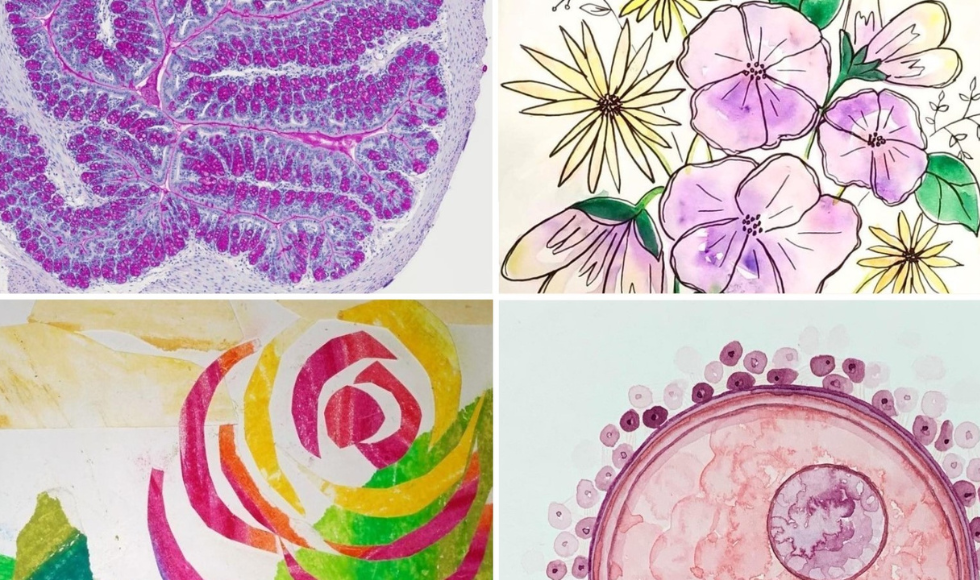Can art, music and drama help prevent another pandemic?

A science communication research project called The Art of Creation is exploring the use of visual art, dance and music in helping researchers share vital health information.
BY Beth Gallagher
April 11, 2023
If the pandemic has taught us anything, stern warnings, numbers, graphs and maps aren’t enough to influence behaviour, says Deborah Sloboda.
But visual art, dance and music just might be.
“Art is emotive and you don’t have to be academically literate to understand and reflect on art,” says the professor in McMaster’s Department of Biochemistry and Biomedical Sciences.
“Art doesn’t select for individuals who can understand the words I’m saying, or those who are able to understand the papers we publish.”
And so the reproductive biologist is looking to use art as a tool to share complex research findings with communities through a science communication research project called The Art of Creation.
The project will explain the importance of being healthy before and during pregnancy to the public. The communication of this information is just as important as the science itself, says Sloboda.
“It is our obligation as scientists and health practitioners to ensure our messaging to the public is accurate, full of facts … and, even more important, that these messages reach everyone.”
A healthy start in life
The project, through a combination of art and science, aims to foster discussion about the biology of a healthy start in life.
For instance, Sloboda bets most people are aware of the relationship between a pregnant person’s health and the development of a healthy baby.
But how many people know that fathers pass down more than just their genes — impacting their children’s life-long heath too?
Sperm and seminal fluid influence how the uterus prepares for the incoming embryo and the growth of the placenta, which means fathers also play an important role in establishing the environment of the womb and the long-term health of their offspring, says the researcher.
But Sloboda doesn’t blame parents for not knowing about the research that shows the importance of being healthy prior to pregnancy. She blames scientists for not doing a good job of communicating these facts with the general public.
Educating people about vaccines, masking
While her current project is about sharing the science behind early-life factors that affect the health of the next-generation, Sloboda says an arts-based approach to science communication can be used by any researchers who want to educate people about vaccines, masking and other tools that can prevent the next outbreak from becoming a pandemic.
Sloboda points out that advocating for and supporting pregnant people and their partners is a community effort, just as the best hope for pandemic prevention happens when everyone understands science and is deeply connected to the well-being of their neighbours.
“Educating the community to support pregnant people is like helping people understand that masking supports the health of the whole community, especially individuals more vulnerable than themselves.”
Bringing artists into the lab
Sloboda’s current research project on the early origins of health and disease will culminate in an exhibition at the Hamilton Art Gallery in the fall. Professional artists, who were brought into her lab to ask questions and observe scientists, have created works of visual art, dance and spoken word to express what they learned.
Another phase of the project involved pregnant people creating their own artwork after participating in arts-based workshops.
Last year, the Art of Creation project ran more than 30 art workshops, presented at two conferences, and established an Artist Residency Program with seven talented artists.
Sloboda and her team are collecting qualitative data that is showing promising results with artists and pregnant participants reporting changed behaviours and a deeper understanding of science.
She was also thrilled to discover that the pregnant participants have formed support groups and continue to make art.
Connected communities who understand science and can support one another through tough times will be able to make better decisions for future pregnancies or infectious disease outbreaks, says Sloboda.
Now is a good a time as any to lay the groundwork for culture change, says Sloboda. “Arts-based messaging can be used on a global scale. Everyone has communities that need to understand complex ideas in a manner that is accessible. It’s going to take a long time to change culture, so it needs to start now.”


